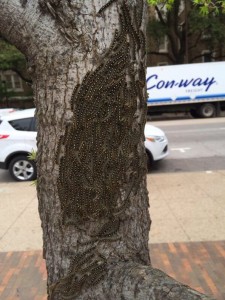
Forest tent caterpillars rest between feedings on a silken mat where they may be easily seen and treated. Photo via NBCDFW Channel 5 TV.
Forest tent caterpillars are one of the most widespread and abundant of the tent-making caterpillars. Like their close cousins the eastern tent caterpillars, forest tent caterpillars feed primarily on trees; but unlike their cousins, and the common fall webworm, the forest tent caterpillar doesn’t make an actual tent. Instead the caterpillars aggregate between feedings on a silken mat which they spin on some area of the trunk or on large branches of the host tree.
Forest tent caterpillars are relatively easy to recognize. Besides their distinctive aggregation behavior, caterpillars can be recognized by their dark-gray to brownish body color, with pale-blue and yellow lines extending along each side, and a chain of distinct whitish shoeprint-shaped spots running down the middle of their back. After completing their immature development in two or three weeks, they pupate and eventually turn into a handsome but mostly obscure brown moth.
Forest tent caterpillars appear once a year, usually in April, sometimes in very large numbers. Then they “disappear” for a whole year until the cycle begins again. Some years caterpillar numbers are very high, but most years they may be noticed only by the sharpest-eyed observers. The cycles of up and down appear to be driven by a combination of environmental and natural control factors, like birds and parasitic insects. This may be one of those abundant years, at least for some areas. Sam Houston Electrical Cooperative reported dozens of power outages this month from masses of tent caterpillars covering electrical transformers, causing fuse overloads. I have received several emails over the past few days from residential areas with pictures of caterpillars massed on their silken mats.

Heavy caterpillar infestations on neighboring trees overflow onto an electrical transformer. According to Sam Houston Electric Cooperative there have been dozens of power outages caused in this way in the past week. Photo by Sam Houston Electric Coop.
If your favorite tree has a case of these leaf feeding caterpillars, there is probably little reason for concern. Most trees can easily withstand 20% loss of foliage with no harm, and in most residential locations most infestations will likely not have a major impact on tree foliage. In the event of heavier infestations, even when trees are completely defoliated, deciduous trees usually re-leaf and recover quickly. However when other stressors are present (e.g., drought, disease, physical damage to the tree from construction, etc.) and there is heavy defoliation, trees may experience slowed growth or dieback of parts of the tree.
If you notice trees with lots of caterpillars you may be able to protect at least some of the foliage by treating with insecticide applied through a hose-end sprayer. Spinosad and Bacillus thuringiensis are two low-impact insecticide ingredients that are effective against caterpillars. Even better, if you can see and have access to the large resting mats of caterpillars on the trunk, simply spot treat the caterpillar aggregation with a spray bottle using insecticidal soap, horticultural oil, or any pyrethroid insecticide. Such applications, being very targeted, will control the caterpillars with little impact on other beneficial insects.
For lighter infestations, I recommend letting the caterpillars be, and let the birds have their way with them. For more information on tent caterpillars, see https://insects.tamu.edu/extension/publications/epubs/e-218.cfm